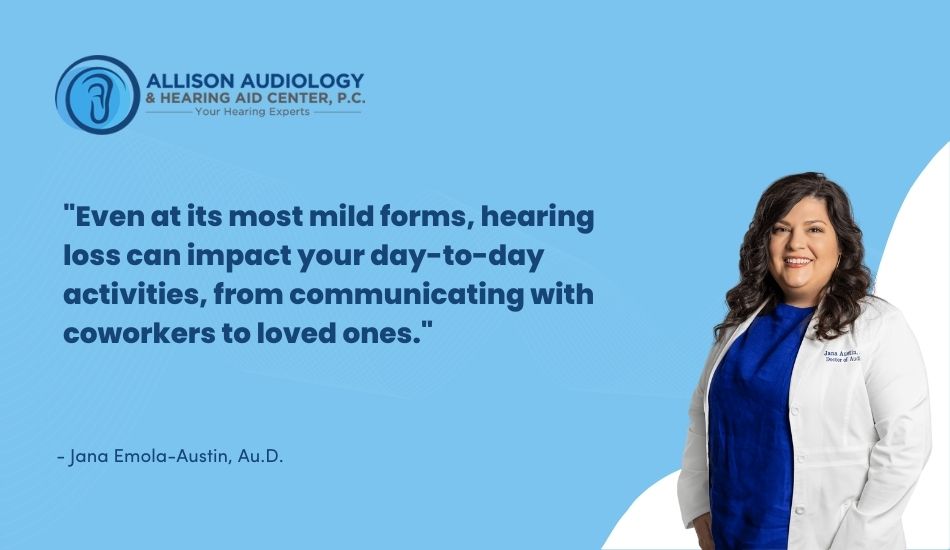Over the last five decades, hearing aid technology has improved vastly in the sizes, styles and features available to individuals with hearing loss. Even at its most mild forms, hearing loss can impact your day-to-day activities, from communicating with coworkers to loved ones. Once you have had your hearing tested and with a skilled audiologist, it’s important to learn more about hearing loss and the available technology.
Hearing loss facts
- There are 48 million people in the United States with hearing loss.
- Two out of three people over 75 years old have age-related hearing loss
- One out of three people over the age of 65 have varying degrees of hearing loss
- Tinnitus affects 50 million people in the United States and can be present with hearing loss
- 14% of people ages 45-64 have some degree of hearing loss
- Noise exposure is one of the leading causes of hearing loss. And, while noise-induced hearing loss is preventable, it can also be permanent. Interestingly, even 15 minutes per day in a noisy subway is enough to cause permanent damage over time. The same applies to having headphones turned up above 60% volume for more than 60 minutes a day.
Types of hearing loss
Hearing loss can present in different ways, and while the symptoms may be similar, the causes behind each kind can vary. Hearing loss types include:
Sensorineural hearing loss:Types of hearing loss
Hearing loss can present in different ways, and while the symptoms may be similar, the causes behind each kind can vary. Hearing loss types include:
Sensorineural hearing loss: This type of hearing loss indicates that there is a problem in the organ of hearing or the nerve of hearing. There might be damage to the inner ear (cochlea, the auditory centers of the brain, or the auditory nerve. A person who has sensorineural hearing loss will likely benefit from a cochlear implant, medical management, communication therapies, and/or a hearing aid.
Conductive hearing loss: This type of hearing loss presents when there is a problem with the mechanisms that conduct sound to the inner ear. This may be problems with eardrum bones or hearing (the middle ear) or the outer ear (external auditory canal). It is often the case that this type of hearing loss may be corrected with surgery or medication. However, the individual can typically benefit from a hearing aid, as well.
Hearing aid facts
A hearing aid is a small, battery-powered device. It is tiny enough to wear comfortably tucked behind your ear, in your ear or in the canal, and they amplify the sound from the external environment.
Here is how they work:
- A microphone picks up the sounds around you
- An amplifier makes the sounds louder
- A receiver then sends these amplified sounds into the ear
How they help:
Hearing aids are typically used to improve speech comprehension and hearing of people who have hearing loss. Usually, the user will have damage to the sensory cells in the inner ear. These are called hair cells. Hearing aids amplify the sounds they have difficulty hearing. It is thought that as little as one in five people who could benefit from a hearing actually use one.
A hearing aid will magnify the sound vibrations that enter the ear. Undamaged and surviving hair cells detect the more significant vibrations and turn them into neural signals that then get passed to the brain. The more damage a person’s hair cells have, the more severe the hearing loss will be. The hearing will, therefore, need more powerful amplification to balance it out.
Hearing aid types
In the canal (ITC): ITC hearing aids fit, as the name suggests, into the ear canal. They come in three styles, ITC, completely in canal (CIC) and invisible in canal (IIC). CIC devices are smaller than an ITC style and are almost hidden totally within the ear canal, while IIC hearing aids are virtually undetectable. These devices are typically recommended for individuals with mild-to-moderate hearing loss.
In the ear (ITE): ITE hearing aids fit completely inside the outer ear bowl. They are used for mild-to-moderately-severe hearing loss. The case that contains the electronic components is made of a durable plastic and come in full and half shell styles to improve comfort and the listening experience.
Behind-the-ear (BTE): BTE hearing aids are made of a hard plastic case that is worn snuggly behind the head and connected to a plastic earmold. These are the type that people are most familiar with. The electronic parts of the hearing aids are in a case behind the ear. The sound will travel from the hearing aid and into the earmold. These styles of hearing aid are work by people of all ages and are typically for people will mild-to-profound hearing loss. There are other styles, such as an open-fit that help prevent earwax build-up – while the main part still goes behind the ear, only a narrow tube fits into the ear canal.
Finding the right hearing aid is essential to improving your listening experience. The audiologist at Allison Audiology & Hearing Aid Center, P.C. has the knowledge and skills to help you find the solution to meet your needs. Contact one of our team members at:
Houston: 713-827-1767




